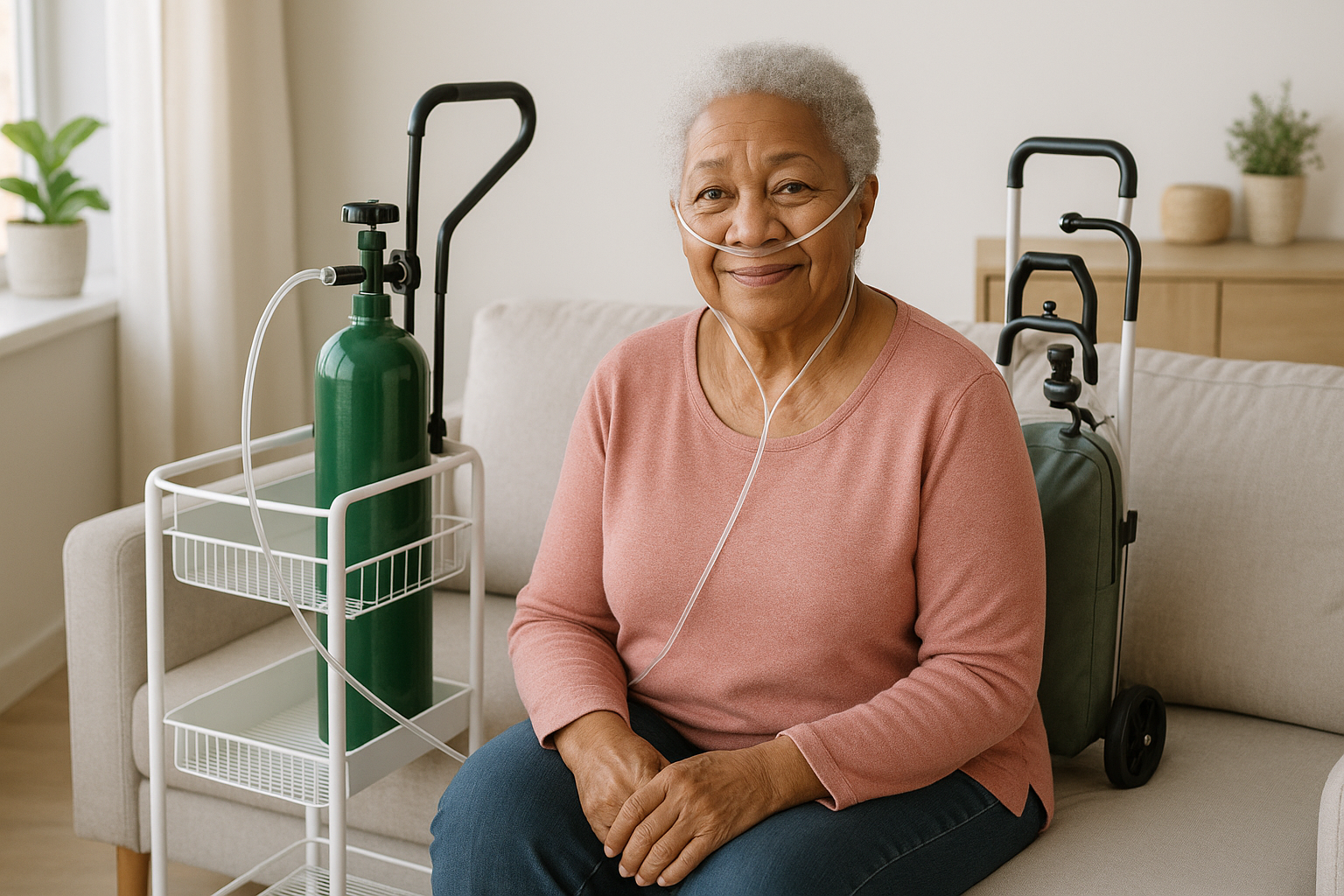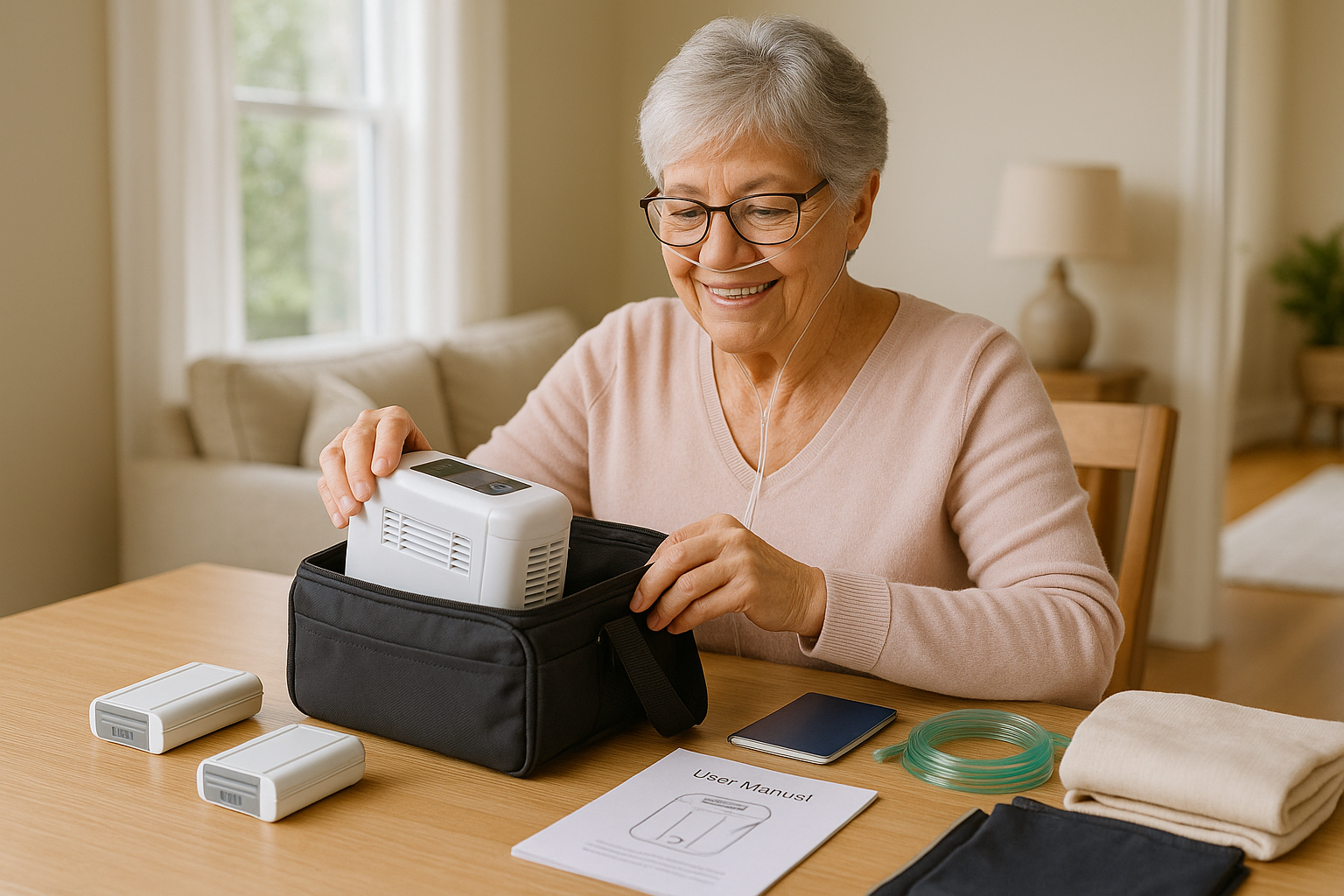
COPD Oxygen Tank Accessories: Carts, Cannulas & Storage Solutions
Explore essential oxygen tank accessories for COPD management, including carts, cannulas, and storage solutions to enhance mobility and safety.
Take Control of Your COPD - Discover Tools Used by 50,000+ Patients. From daily oxygen monitoring to sleep-saving air purifiers, find the exact products your pulmonologist wishes you knew about. Every recommendation tested by real COPD patients.

Ultra-quiet 52dB portable inverter generator that delivers clean, medical-grade power to keep oxygen concentrators, nebulizers, and COPD equipment running during power outages—at just 33 pounds with 9-hour runtime.
Westinghouse iGen1200 Super Quiet Portable Inverter Generator
This post contains affiliate links. We earn a commission if you make a purchase, at no additional cost to you.
Does the thought of losing power during a storm make you panic about your oxygen concentrator shutting off? Are you tired of worrying whether your portable oxygen concentrator will die during extended power outages? What happens to your breathing treatments when the electricity goes out for hours or even days?
COPD patients who rely on oxygen concentrators, nebulizers, and other powered medical equipment face a frightening reality during power outages. Your oxygen supply stops. Your nebulizer goes silent. Your lifeline to easier breathing gets cut off exactly when you need it most.
Traditional gas generators are too loud, too heavy, and produce dirty power that can damage sensitive medical equipment. You need reliable backup power that's quiet enough for neighborhoods, clean enough for medical devices, and light enough to actually use.
Check out the Westinghouse iGen1200 here and discover the compact powerhouse that keeps your breathing equipment running when the grid fails you.
The Westinghouse iGen1200 Super Quiet Portable Inverter Generator delivers exactly what COPD patients need: clean, reliable backup power for medical equipment at an incredibly quiet 52 dBA—quieter than a normal conversation.
The standout feature for COPD patients: It produces clean power with less than 3% total harmonic distortion (THD), making it safe for sensitive electronics like oxygen concentrators, pulse oximeters, and nebulizers that can be damaged by dirty power from traditional generators.
At just 33 pounds with a built-in carrying handle, the iGen1200 provides 1,200 peak watts and 1,000 running watts—enough power to run most portable oxygen concentrators (120-600 watts) plus charge phones and power LED lights simultaneously.
💰 Current Price: Around $600-700 (varies by retailer)
⭐ Amazon Rating: 4.3/5 stars from 1,000+ verified customers
🚚 Free shipping available
Get yours now
The revolutionary Efficiency Mode automatically adjusts engine speed to match your power needs, providing up to 9 hours of runtime on just 0.8 gallons of gas—perfect for extended outages.
Unlike traditional generators that produce "dirty" electricity, the iGen1200 delivers pure sine wave power with less than 3% THD—the same quality power that comes from your wall outlet. This protects expensive medical equipment from power surges and electronic damage.
You can literally have a normal conversation standing right next to it. Customer reviews consistently mention the incredible quiet operation: "My wife called soon after I started it, and even though it was literally 10" from my feet she could not hear it running in the background."
With 1,000 continuous watts, the iGen1200 can power:
At 33 pounds with an ergonomic carrying handle, this is lighter than most suitcases. No wheels required—one person can easily carry it from storage to where it's needed.
| Feature | Westinghouse iGen1200 | Traditional Generator | Honda EU1000i |
|---|---|---|---|
| Weight | 33 lbs | 80-120 lbs | 29 lbs |
| Noise Level | 52 dBA | 75-85 dBA | 53 dBA |
| Clean Power (THD) | <3% | 10-15% | <3% |
| Runtime | 9 hours (25% load) | 6-8 hours | 8.1 hours |
| Price | ~$600-700 | $300-500 | $1,100+ |
| Medical Safe | ✅ Yes | ❌ No | ✅ Yes |
Grab the Westinghouse iGen1200 here and stop worrying about your medical equipment during outages.
"I was looking for an easy to carry generator to run electric tools. After seeing a Honda EU1000 at a boat show and being impressed by how quiet and light it is, I did not buy one because of the price. This Westinghouse iGen1200 has about the same features as the Honda at half the price." - Verified Amazon Customer
"It's extremely quiet. My wife called soon after I started it, and even though it was literally 10" from my feet she could not hear it running in the background... using only a pint for approx 1 hour of use was incredible!" - Amazon Customer Review
💰 Emergency Preparedness Investment:
Price of this generator: ~$600-700
Cost of emergency room visit from oxygen shortage: $1,000-5,000+
Peace of mind during power outages: Priceless
Check current pricing
Real-World Performance: Customers report the iGen1200 easily starts with 1-2 pulls, runs up to 9 hours on less than a gallon of gas, and produces power clean enough for the most sensitive electronics.
Here's what you can expect with the Westinghouse iGen1200:
Week 1: You'll have confidence knowing your backup power is ready. Test it monthly with your oxygen concentrator to ensure everything works seamlessly together. The quiet operation means you can run it day or night without disturbing neighbors.
First Power Outage: When the lights go out, you'll be ready. Simply wheel out the generator, add gas, pull the cord 1-2 times, and plug in your medical equipment. Your oxygen keeps flowing, your nebulizer keeps working, and your CPAP stays powered all night.
Long-term Peace of Mind: With proper maintenance, customers report years of reliable service. You'll sleep better knowing your breathing equipment has backup power whenever storms or grid failures threaten your air supply.
Q: Will this power my home oxygen concentrator?
A: Yes, for most units. Home oxygen concentrators typically use 275-600 watts. The iGen1200 provides 1,000 continuous watts, so it can handle most 5-liter and smaller concentrators. Check your concentrator's wattage label—if it's under 900 watts, you're covered.
Q: How long will it run my oxygen concentrator?
A: Runtime depends on your concentrator's power draw. A 300-watt concentrator would run approximately 6-7 hours on a full 0.8-gallon tank. Higher wattage devices reduce runtime, but you can extend operation by refueling.
Q: Is it really quiet enough for neighborhoods?
A: Yes. At 52 dBA, it's quieter than normal conversation. Many customers run it in their garages, on patios, or outside apartment windows without neighbor complaints. The sound is more like a quiet dishwasher than a traditional generator.
Q: What medical equipment can it power simultaneously?
A: The 1,000-watt capacity allows multiple devices: oxygen concentrator (300W) + nebulizer (75W) + CPAP (50W) + phone charging (10W) + LED lights (40W) = 475W total, well within capacity.
Q: How often should I test it?
A: Run it for 15-20 minutes monthly to keep fuel fresh and engine lubricated. This ensures it starts reliably when you need it for emergencies.
Get your Westinghouse iGen1200 now and ensure your breathing equipment never stops working.
The Verdict: The Westinghouse iGen1200 delivers Honda-quality performance at half the price. For COPD patients who need reliable, quiet backup power for medical equipment, this generator provides excellent value and peace of mind.
Worth the Investment? At $600-700, you're getting professional-grade backup power that could prevent emergency room visits during extended outages. The clean power output protects expensive medical equipment, and the quiet operation makes it practical for regular use.
Next Steps: For comprehensive power planning, check out our complete guide to backup power for oxygen concentrators or browse our COPD emergency preparedness directory.
For more respiratory emergency planning, read our guide on portable oxygen concentrator backup strategies to build your complete power independence system.
Last updated: September 11, 2025 | Medical disclaimer: This content is for informational purposes only and should not replace professional medical advice. Always consult your healthcare provider about backup power needs for medical equipment.

Explore essential oxygen tank accessories for COPD management, including carts, cannulas, and storage solutions to enhance mobility and safety.

Discover the top portable oxygen concentrators for COPD in 2025. Compare top POCs for weight, battery, noise, and FAA approval. See picks for travel, longest runtime, and budget—plus FAQs, insurance, and safety tips. Updated October 2025.

Prepare for travel with a portable oxygen concentrator by following essential packing tips, battery requirements, and medical documentation advice.